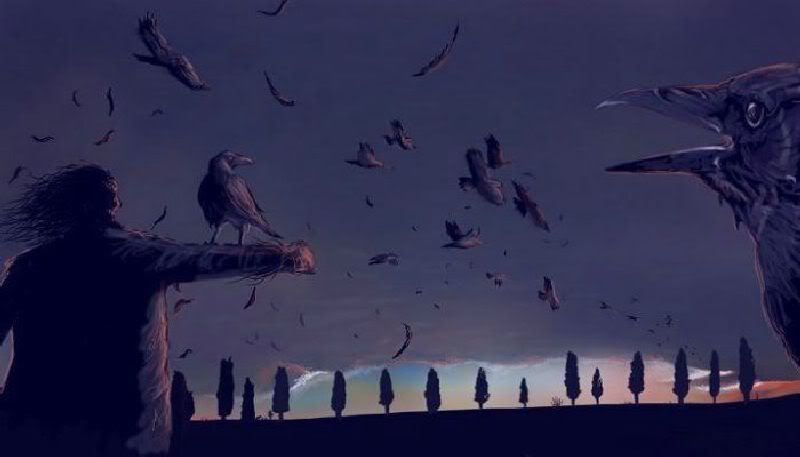(121) Magpies in medieval Europe

Figure 1. Fox with Birds, including Magpie, Isabella Psalter, Bayerische
Staatsbibliothek München [MS gall. 16], fol. 13r, England, 1303-1308.
Reprinted with permission.
Black with large swathes of white on its breast and wing, the magpie had
some interesting and well-known connotations in the bestiaries of medieval
Europe. These books often included the story of the fox pretending to
be dead, luring the magpies to his body, only to snap them up when they
attempted to eat his tongue. As depicted in the margins of the fourteenth century
Psalter of Queen Isabella of England (Figure 1), or the thirteenth century
bestiary MS Bodley 764, the fox’s treatment of the magpies is
described as “the symbol of the devil, who appears to be dead to all living
things until he has them by the throat and punishes them.” In Richard of
Fournival’s Bestiary of Love, the fox deceiving a magpie is likened to uncaring
men who pretend to be in love in order to seduce women: “A man will
say he is dying of love when he feels no pain or hurt, and these deceive
good folk just as the fox deceives the magpies.” It would appear that just
such an interpretation is intended for the bird in the “Hall of Justice”
ceiling paintings. The magpie appears three times in the ceilings, and is
always found in the vicinity of the Lady: twice on the hunting ceilingand
once on the battle ceiling (Illustration 6, in tree to left of castle;
Illustration 11, top center, left of starred panel; Illustration 15, lower
center). Although there are certainly numerous meanings that might have
been associated with this bird, its insistent visual connection with the Lady
may be intended to convey her position as the focus of the attentions of
several knights, perhaps not all of them with the noblest of intentions.
Magpies are not always represented as victims, however, for outside
the context of the fox story, they are usually portrayed as birds of prey.
This facet of their character is reflected in the fox story itself, their intentions
being to consume the carcass of the fox they believe to be dead. The
magpie, then, can be interpreted as representing both pursuer and pursued.
As such, the bird’s association with the lady indicates far more
than victimization, either of itself or of the Lady; rather, the magpie may
bring resonances of duality and ambiguity, suggesting that the Lady is,
not only the object of male desire, but also a savvy player in the courtly
games that transpire in the ceilings. Moreover, the magpie’s duplicity
may reference the instability and negotiation necessary not only in romantic
exchanges, but also in strategic engagements, a reading that is especially
pertinent to the sensitive relationship between the Nasrids and their Christian
allies.
Careful navigation in the realms of words as well as of actions was
important to both the Nasrids and their Christian neighbors, and further
associations offered by the magpie may also suggest some of the uncertainty
of negotiating across language and culture. In a common Latin bestiary
text, magpies are noted as poets because “they can speak words with
different sounds, like men;” in addition to the positive associations such
qualities would appear to carry, they also suggest a talent for the manipulation
of words, which may be used in the production of effusive and false
praises as well as in the creation of verse. The Latin word for the magpie,
Picus, is interpreted as a reference to “Saturn’s son, because he used them
in foretelling the future.” The text states that “you may think what you
like” of the stories associated with the magpie, such as its purported prophetic
talent or divinity, but “the sound of its voice may mean either the
loquacity of heretics or the discussion of philosophers,” thus implying the
ambiguous duality of the bird’s symbolism. For the Nasrid patron of
these paintings, whoever he may ultimately have been, the magpie may
serve as a reminder that one’s allies can quickly become threatening, and
that being prepared for the words of either the heretic or the philosopher
may protect one’s interests. On a visual level, such ambiguities as those
associated with the magpie may have also served to draw the viewers’ interests
to the animals and the background in general, and attest to the
importance of the background scenes to the overall comprehension of
the paintings.
http://art.okstate.edu/faculty/borland.pdf

![[Go to Site Index]](http://i6.photobucket.com/albums/y225/Abramelinn/Banner_Crow4.jpg)

<< Home